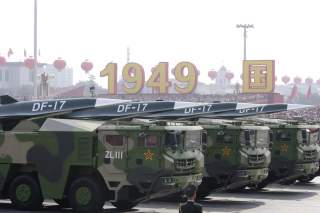Now There Are Two of Them: Meet China's Crazy Fast Hypersonic Missiles
Well that's no good.
Key point: Bejing is racing ahead to ensure it has the best hypersonic weapons on the planet. Towards that end, it is testing not one, but two different missiles.
China is testing two hypersonic surface-to-surface missiles and not one as previously reported, state media claimed.
If true, the development of a second munition capable of traveling at least five times the speed of sound while maneuvering could weigh on the balance of power in the Pacific region.
This first appeared earlier in 2019 and is being reposted due to reader interest.
The second missile, the Xingkong-2, differs in detail compared to the DF-17 that made its first public appearance as part of the Oct. 1, 2019 celebrations commemorating the 70th anniversary of the founding of the People’s Republic of China.
“One distinctive difference between the Xingkong-2 and the DF-17 is that the former has a fairing and the latter does not, making the two very different in appearance alone,” Global Times reported.
The DF-17 is a boost-glide system, meaning it launches atop a rocket before separating and gliding at high speed toward its target. Other hypersonic systems under development in the United States and Russia are air-breathing and include their own, integrated motors.
It’s unclear how far along in development and deployment the DF-17 is, to say nothing of the purported second Chinese hypersonic munition.
China first tested the DF-17 in 2013 and apparently rushed the weapon into service. Sixteen DF-17s appeared on their truck-transporters at the October anniversary celebrations in Beijing.
It’s unclear how many of the missiles China possesses in total and how it plans to use the missiles during wartime. Most importantly, it’s not obvious that China has built a sensor network capable of selecting targets for the DF-17.
Global Times claimed the Chinese military first tested the Xingkong-2 in 2018. The new weapon “is not likely to enter Chinese military service as early as 2019,” the government-run media outlet explained.
Russia reportedly has deployed a small number of minimally-tested hypersonic missiles. The United States is taking a more leisurely approach to developing its own family of ground-, sea- and air-launched hypersonic missiles and does not expect to field an operational weapon until the early 2020s, at the soonest.
Hypersonic weapons have the potential to alter the military balance of power. Hong Kong-based military expert Song Zhongping told the Hong Kong South China Morning Post that the DF-17 in conjunction with slower DF-15 and DF-16 rockets could penetrate the U.S.-made missile shields in the region, including Patriot Advanced Capability-3 systems in Taiwan and Terminal High Altitude Area Defense systems in South Korea.
“All the DF-15, DF-16 and DF-17s could build a comprehensive strike network covering everywhere from Taiwan island to the neighbouring countries around mainland China, especially the U.S.’s overseas military bases in the region,” Song said.
“The superiority of the DF-17 is its hypersonic warhead which could penetrate missile-defense networks, radar and early-warning systems, and hit some difficult targets that the DF-15 and DF-16 might be unable to do.”
But David Larter in a November 2019 column in Defense News cautioned against assuming the DF-17 and other hypersonic missiles really are transformative. “The catch is that none of this stuff works yet,” Larter wrote. “I want to emphasize that all of what we’re talking about here are prototypes.”
Larter cited “missile enthusiast” Tom Karako from the Center for Strategic and International Studies in Washington, D.C. Karako “raised the very excellent point that you will likely need airborne sensors to target these things in the future,” Larter explained.
“It’s not just about shooting missiles — you have to have the complete kill chain,” Karako said. “You have to know where they are going to go, and you have to hope your target hasn’t moved since you pulled the trigger.”
Bryan Clark, an analyst at the Center for Strategic and Budgetary Assessments in Washington, D.C., likewise is skeptical of what Larter described as “the hypersonics craze.”
“These boost-glide prompt-strike weapons are really designed to have a strategic effect,” Clark explained.
“There are a small number of weapons, they are really expensive, so you are not going to hit a bunch of targets with them. So even one weapon that’s a hypersonic weapon could still get shot down. You may not be able to generate a bunch of effects with them because they cost so much that you aren’t going to do the thing where you overwhelm the air-defenses and come in from multiple angles with hypersonics because you don’t have enough of them.”
David Axe serves as Defense Editor of the National Interest. He is the author of the graphic novels War Fix, War Is Boring and Machete Squad. This first appeared earlier in 2019 and is being reposted due to reader interest.
Image: Reuters

